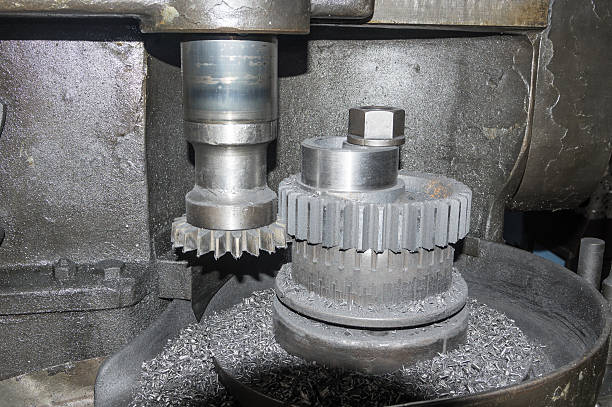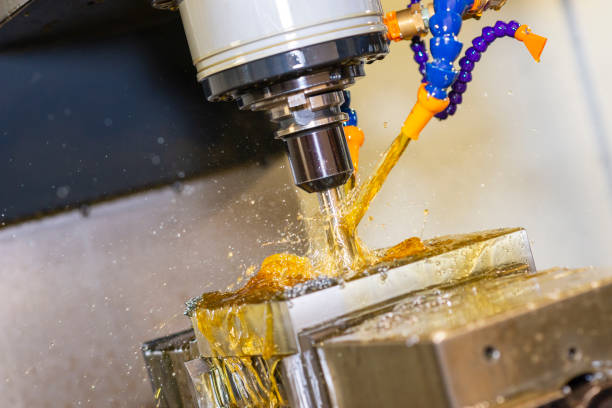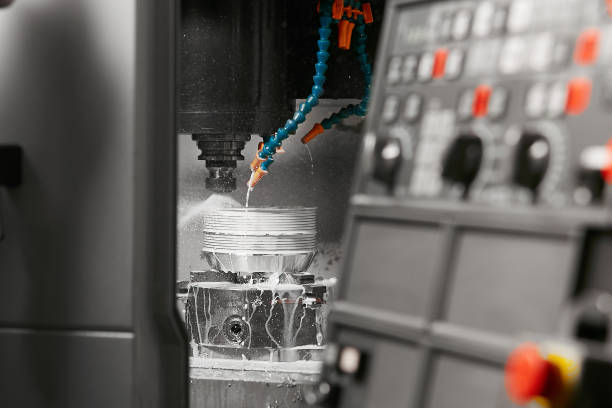CNC spindle motor is crucial for accurate cutting and boring operations. Professional alignment guarantees optimal performance. Misalignment leads to wear and tear hence shorter service delivery.
Regular assessments prevent issues. Correction tools maintain alignment. Take good care of your CNC spindle motor.
CNC spindle motors fail from vibration. Excessive vibration is common in misaligned bearings. High RPMs intensify this impact. Vibration has the effects of wearing out the critical components.
Thus, fatigue increases the likelihood of the breakdown of motors. Spindle bearings that operate at 20, 000 RPM are particularly at risk. Consistent monitoring is essential.
Detection of the levels of vibration is important since it may lead to failure. Engineers should use the techniques of reducing vibrations. These risks are however prevented by regular maintenance. It also minimizes vibration in the system Lubrication has been known to greatly reduce wear and tear.

CNC spindle motors have alignment errors. Misalignment of shafts leads to imbalance. Misalignment stresses motor components. Bearing and couplings are affected first. An alignment error of 0.01 mm is critical. Long-Term Relationship Consequences: Misalignment results in failure over time.
These precision alignment tools are needed. Periodic alignment checks contribute to increasing the longevity of the motor. Training should be properly done to ensure the right kind of alignment.
Alignment protocols have to be followed by engineers. Maintaining constant surveillance is useful in identifying cases of misalignment at an early stage.
CNC spindle motors are damaged through overloading. Crossing load ratings places pressure on the components. Motor windings are especially problematic.
Overloads can cause overheating. Thermal sensors assist in identifying this problem. A spindle of 5kW rating should not over load the machine. Load monitoring systems are crucial.
It is imperative that operators pay attention to the load requirements. Freight inspections can also aid in detecting overloading. Thus, avoiding overloads contributes to motor durability. Effective training reduces the likelihood of overworking.
Heat is an enemy of the CNC spindle motor. Excessive heat degrades insulation. Heat is also a problem affecting bearings. Motors that are rated for 60°C must be monitored.
Thermal sensors are capable of detecting early cases of overheating. Motor cooling systems are very essential for motor health. Maintenance of the cooling systems should be done as regularly as possible.
Heat can cause motor failure. It is important to take temperatures frequently. Motor temperature can be regulated through proper ventilation. Heat problems must be solved by engineers.
Contamination causes the CNC spindle motor to fail. Dust and debris penetrate into motor housings. Contaminants have very negative effects on the bearings and seals of the vehicles.
The filters and seals are very useful for protection purposes. This means that failure risk is heightened when the environment is contaminated. Regular cleaning is necessary. Proper enclosures prevent contamination. Engineers should use high quality filters.
It is important that contamination levels are monitored at all times. Measures of prevention help to avoid contamination. Maintenance is very important as this will help in prolonging the life of the motor.
Selecting the best lubricant is important when it comes to CNC spindle motors. Mineral oils are sometimes outperformed by synthetic oils. It is a matter of viscosity; ISO VG 32 is standard. Reducing the wear on bearings is made possible through proper lubrication.
Always follow manufacturer recommendations. The high-speed spindles thus require special types of lubricants. Seal compatibility is essential. The use of wrong lubricants leads to early failure.
Regularly review lubricant specifications. This makes it possible for the spindle to perform optimally. Lubrication is a critical factor that influences the life expectancy of motors.

Proper application of lubricant is critical. This can be done manually or automatically. Accuracy is important for equal spreading. Lubrication is important but when it is done in excess it will harm parts. It’s always advisable to use the right quantities.
Oil mist lubrication is particularly suitable for high speed bearings. They are good in giving controlled application. Guarantee that lubrication extends to the critical regions.
Daily practice is useful in ensuring that one’s technique is correct at all times. Appropriate use prolongs spindle existence. Lubrication efficiency has an effect on performance.
Lubrication frequency impacts the health of CNC spindle motor. Regular intervals prevent wear. Some of the high-use spindles may require daily inspection. Follow the manufacturer's schedule. Normally it is done every 500 hours as is common. It also makes usage trackable through automated systems.
Log maintenance activities monitored consistently. This helps identify patterns.
They should be adjusted according to the conditions under which the company is operating. Scheduling is an effective way of maintaining steady output. Regular lubrication reduces downtime. Compliance with guidelines deters excessive spending on repairs.
It is very important to monitor lubrication systems. Lubricant levels and its quality are monitored by the use of sensors. Real-time data is useful to avoid failures or system breakdowns. Excessive vibrations could be a sign of lubrication problems. Temperature sensors detect overheating.
These automated alerts enhance response time. Regularly calibrate monitoring equipment. Trend analysis should be done with the help of specific software. Prolonged observation helps to lengthen spindle duration. Failure is costly, especially when it happens when it is least expected.
Investing in monitoring systems brings benefits. Effective supervisions imply the right degree of lubrication.
CNC spindle motor requires proper cooling to enhance its life span. Water-cooled systems use circulating liquid meaning that heat is reduced efficiently. Air-cooled systems use fan which requires less maintenance as compared to water cooled fans. It affects the operation of motors and ensures that they do not overheat. Appropriate cooling can reduce spindle temperature by 10°C.
Thermistors have the ability to measure changes in temperature. Cooling as a continuous process keeps the motors effective all through. Maintenance keeps off system breakdowns.
Each of the cooling types has its own usage. Select depending upon the type of motor required and the amount of work that needs to be done.
Daily, weekly, and monthly inspections help to identify problems with CNC spindle motors. Check for blockages in cooling lines. Check that the fans work properly in order not to overheat. Temperature sensors should be tested periodically for accuracy.
Monitor the coolant flow rates; this depends on the kind and size of the motor involved. Safeguard connections to prevent any leakage. Employ diagnostic tools to flag possible problems. Checks are made every 500 operating hours. Regular maintenance enhances performance.
Always refer to the manufacturer’s recommendations on specific parameters. It is cheaper to identify the probable issues early.
Proper coolant flow must also be maintained. Tune the flow rates to the spindle motor specifications. High flow is useful to avoid overheating but it leads to pressure drops. Low flow poses the danger of inadequate cooling. Flow rates should therefore be measured with flow meters. Ensure that there are no blockages in coolant hoses from time to time. Automate flow control systems.
Tend to apply consistent pressure to enable the proper cooling process. Efficient flow control increases the durability of motors. Closely monitor the flow rate with thermal cooling capacity. Tuning is vital in order to reach peak performance.
Measuring heat dissipation enhances spindle motor durability. Keep track of temperature changes during operation. Evaluate the effectiveness of the cooling system relative to the specified standards of manufacturers. Monitor the temperature of the coolant before and after application.
Assess the energy efficiency of the cooling systems. Perform thermal imaging to get accurate measurement. Determine regions where cooling inefficiency is most likely to occur. Be proactive in monitoring and analyzing system performance data.
The findings should then be used to make the necessary changes. The checks should include efficiency assessments. Increased efficiency also results to decreased tear and wear.
This is one of the ways that can ensure that the CNC spindle motor will last for a long time. Clean the cooling systems to remove debris. Replace worn-out parts promptly. Ensure that all moving parts are lubricated with the right lubricant. Schedule the periodic inspections.
Measure the temperature and flow rates. Maintain a log book for tracking purposes. It is important in order to avoid incompatibility issues to use quality replacement parts. Follow manufacturer maintenance schedules. Educate the staff on correct practices of maintaining equipment.
Preventative maintenance helps avoid a machine or a system breaking down when you least expect it.

CNC spindle motors wear out with time as reflected by higher run out which is an indication of low precision. The bearings can wear out over time and lead to vibrations that can be easily felt.
Another way the motor shaft can wear is through misalignment. Periodically, force is applied unevenly, which leads to the deterioration of the tool life over time.
The spindle speeds may go below the rated RPM and this may causes problems. Some of the common areas that need regular checkup may be characterized by cracked housing. It is equally important to ensure that they are well maintained to avoid having to carry out major overhauls.
Sounds that are not typical indicate wear of the motor in a CNC spindle. Grinding bearings is a sign of a problem. Rattling noise may be caused by loose parts. These whining sounds indicate belt problems. Constant fluctuations in noise must be addressed as soon as possible.
It is also very common to hear strange noises coming from motor cooling fans. Electrical failure could be a reason for sudden silence. Early identification is also made possible through routine surveillance. Lubrication also plays an important role in reducing noise.
Huge vibrations indicate a problem with the CNC spindle motor. When the tools are imbalanced, they create much vibration. This is because worn bearings cause an increase in spindle oscillation. These problems are discovered early through regular checkups.
Vibrations are known to have an impact on the quality of the surface finish. Some of the causes include: the motor shaft may be misaligned. Vibration levels can be measured with a good degree of accuracy using advanced sensors. Regular patterns of vibration suggest wear evolution.
This means that, once an issue arises, it should be dealt with as early as possible in order to avoid exacerbation.
Increase in temperature in a CNC spindle motor is a sign of wear. Stress usually leads to bearing overheating. High temperatures indicate that cooling systems have failed. These problems can however be detected through regular checks. Heat load degrades motor effectiveness.
Modern thermometers can reflect variations in temperature. The life of the motor is highly sensitive to overheating. Maintenance of cooling is very important. A stitch in time saves nine.
It is very important to avoid overloads in the motors of the CNC spindle. Motor ratings and load capacities should be checked periodically. Control heat with cooling systems. This should be avoided by setting appropriate limits for speed (RPM). Install load sensors for stress measurement.
Maintenance helps avoid deterioration. This will ensure that the spindle bearings are well lubricated. Overload trips should be properly set. Instructing operators on machine limits is crucial.
Monitoring of spindle motor load contributes towards effective operations. Place load meters in order to monitor the current consumption. Real-time data enables avoidance of overloads. High load conditions should be indicated by software alerts. Monitor load history for cycles.
Ensure that the voltage and current ratings are correct. The feed rates should then be adjusted in a bid to achieve balance. Implement IoT devices for enhanced observation. Maintain records of all load data.
To reduce damages caused by overloads, they should be addressed as soon as possible. Turn off the machine at once. Check whether the spindle motor is running hot or not. Look and listen for any strange sounds that you have not heard before. Reset overload protection devices.
Check the reliability of cooling systems. Inspect wiring and connections. It is also important to replace any damaged components as soon as possible. Boot up the machine gradually.
To begin with, switch off the CNC machine. Allow the spindle motor to cool. Inspect for visible damage. Replace burnt fuses and reset circuit breakers…Check the spindle bearings.
Start the motor at a lower load. Gradually increase the intensity while observing the load. Ensure you monitor the Spindle temperatures carefully. File the incident for reference purposes in case they are needed in the future.
It is crucial for the longevity of your CNC spindle motor to constantly check for misalignment and its consequences, as well as applying correction measures. There are few things more critical than regular assessment and the use of quality alignment tools. Take good care of your CNC spindle motor.
Visit CNCYANGSEN. Check out the blogs on this site for more tips and tools to help you keep your equipment in good shape. Make your motor run and last longer.